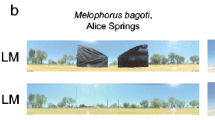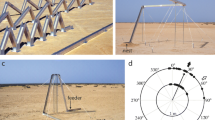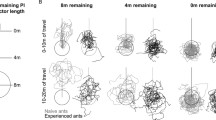Abstract
Desert ants (Cataglyphis fortis) navigate by means of path integration, and perform accurately even in undulating terrain. They are able to correctly calculate the ground distance between nest and feeder even if their foraging excursion leads them over corrugated surfaces. To compute the respective ground projection when walking over an inclined surface, ants must measure its slope with sufficient accuracy—but how they do so is still not understood. Using a new behavioural assay that included a negative reinforcement, we investigated how well different slopes are discriminated by the ants. Ants were trained to visit an elevated feeder, via a ramp of fixed inclination (five training inclinations were used: 0°, 15°, 30°, 45°, 60°). The ants discriminated a steeper test slope that differed from the training slope by 12.5°. This discrimination performance was found to be constant for training slopes between 0° and 45°. Ants trained on a 60° slope, however, did not discriminate all steeper slopes, up to a vertical ascent, from the 60° inclination. The consequences of this discrimination accuracy for errors in the path integration process are discussed.







Similar content being viewed by others
References
Bässler U (1967) Zur Regelung der Stellung des Femur-Tibia-Gelenkes bei der Stabheuschrecke Carausius morosus in der Ruhe und im Lauf. Biol Cybern 4:18–26. doi:10.1007/BF00288822
Bückmann D (1954) Die Leistungen der Schwereorientierung bei dem im Meersande grabenden Käfer Bledius bicornis Grm. (Staphylinidae). Z vergl Physiol 36:488–507. doi:10.1007/BF00326956
Bückmann D (1955) Zur Leistung des Schweresinnes bei Insekten. Naturwissenschaften 42:78–79. doi:10.1007/BF00589552
Collett TS, Collett M (2000) Path integration in insects. Curr Opin Neurobiol 10:757–762. doi:10.1016/S0959-4388(00)00150-1
Collett M, Collett TS, Bisch S, Wehner R (1998) Local and global vectors in desert ant navigation. Nature 394:710–714. doi:10.1038/28378
Grah G (2008) Die dreidimensionale Orientierung der Wüstenameisen—vereinfachte Repräsentationen von Routen und Räumen: Verhaltensversuche an Cataglyphis fortis. VDM Verlag Dr. Müller, Saarbrücken. ISBN:978-3-8364-9321-5
Grah G, Ronacher B (2008) Three-dimensional orientation in desert ants: context-independent memorisation and recall of sloped path segments. J Comp Physiol A 194:517–522. doi:10.1007/s00359-008-0324-4
Grah G, Wehner R, Ronacher B (2005) Path integration in a three-dimensional maze: ground distance estimation keeps desert ants Cataghlyphis fortis on course. J Exp Biol 208:4005–4011. doi:10.1242/jeb.01873
Grah G, Wehner R, Ronacher B (2007) Desert ants do not acquire and use a three-dimensional global vector. Front Zool 4:12. doi:10.1186/1742-9994-4-12
Heß D, Koch J, Ronacher B (2009) Desert ants do not rely on sky compass information for the perception of inclined path segments. J Exp Biol 212:1528–1534. doi:10.1242/jeb.027961
Jander R, Horn E, Hoffmann M (1970) Die Bedeutung von Gelenkrezeptoren in den Beinen für die Geotaxis der höheren Insekten (Pterygota). Z vergl Physiol 66:326–342. doi:10.1007/BF00297833
Markl H (1962) Borstenfelder an den Gelenken als Schweresinnesorgan bei Ameisen und anderen Hymenopteren. Z vergl Physiol 45:475–569. doi:10.1007/BF00342998
Markl H (1964) Geomenotaktische Fehlorientierung bei Formica polyctena Förster. Z vergl Physiol 48:552–586. doi:10.1007/BF00348849
Mittelstaedt H (1962) Control systems of orientation in insects. Annu Rev Entomol 7:177–198
Müller M, Wehner R (1988) Path integration in desert ants, Cataglyphis fortis. Proc Natl Acad Sci USA 85:5287–5290
Seidl T, Wehner R (2008) Walking on inclines: how do desert ants monitor slope and step length. Front Zool 5:8. doi:10.1186/1742-9994-5-8
Thurm U (1963) Die Beziehung zwischen mechanischen Reizgrößen und stationären Erregungszuständen bei Borstenfeld-Sensillen von Bienen. Z vergl Physiol 46:351–382
Thurm U (1965) An insect mechanoreceptor: part II: receptor potentials. Cold Spring Harbor Symp Quant Biol 30:83–94
Wehner R, Srinivasan MV (2003) Path integration in insects. In: Jeffery KJ (ed) The neurobiology of spatial behaviour. Oxford University Press, Oxford, pp 9–30
Wehner R, Wehner S (1986) Path integration in desert ants. Approaching a long-standing puzzle in insect navigation. Monit Zool Ital 20:309–331
Wehner R, Gallizzi K, Frei C, Vesely M (2002) Calibration processes in desert ant navigation: vector courses and systematic search. J Comp Physiol A 188:683–693. doi:10.1007/s00359-002-0340-8
Weihmann T, Blickhan R (2009) Comparing inclined locomotion in a ground-living and a climbing ant species: sagittal plane kinematics. J Comp Physiol A 195:1011–1020. doi:10.1007/s00359-009-0475-y
Wittlinger M, Wehner R, Wolf H (2007) Hair plate mechanoreceptors associated with body segments are not necessary for three-dimensional path integration in desert ants, Cataglyphis fortis. J Exp Biol 210:375–382. doi:10.1242/jeb.02674
Wohlgemuth S, Ronacher B, Wehner R (2001) Ant odometry in the third dimension. Nature 411:795–798. doi:10.1038/35081069
Wohlgemuth S, Ronacher B, Wehner R (2002) Distance estimation in the third dimension in desert ants. J Comp Physiol A 188:273–281. doi:10.1007/s00359-002-0301-2
Acknowledgments
We thank Mathiijs Boeschoten for his enduring assistance in the field work, Fleur Lebhard for help and discussions, and in particular Rüdiger Wehner for continuous support, many inspiring discussions and helpful comments on the manuscript. Gunnar Grah provided the original data of the 2005 experiment. We gratefully acknowledge the permission, granted by the Tunesian government, to carry out these investigations in this beautiful country. This work was financed by grants from the DFG (Ro 547/10-1) and the Volkswagen Foundation (I/78 574) to B.R. The experiments comply with the “Principles of animal Care” and with the current German law.
Conflict of interest
The authors declare that they have no conflict of interests.
Author information
Authors and Affiliations
Corresponding author
Rights and permissions
About this article
Cite this article
Wintergerst, S., Ronacher, B. Discrimination of inclined path segments by the desert ant Cataglyphis fortis . J Comp Physiol A 198, 363–373 (2012). https://doi.org/10.1007/s00359-012-0714-5
Received:
Revised:
Accepted:
Published:
Issue Date:
DOI: https://doi.org/10.1007/s00359-012-0714-5




